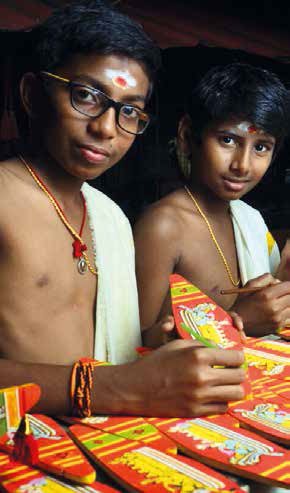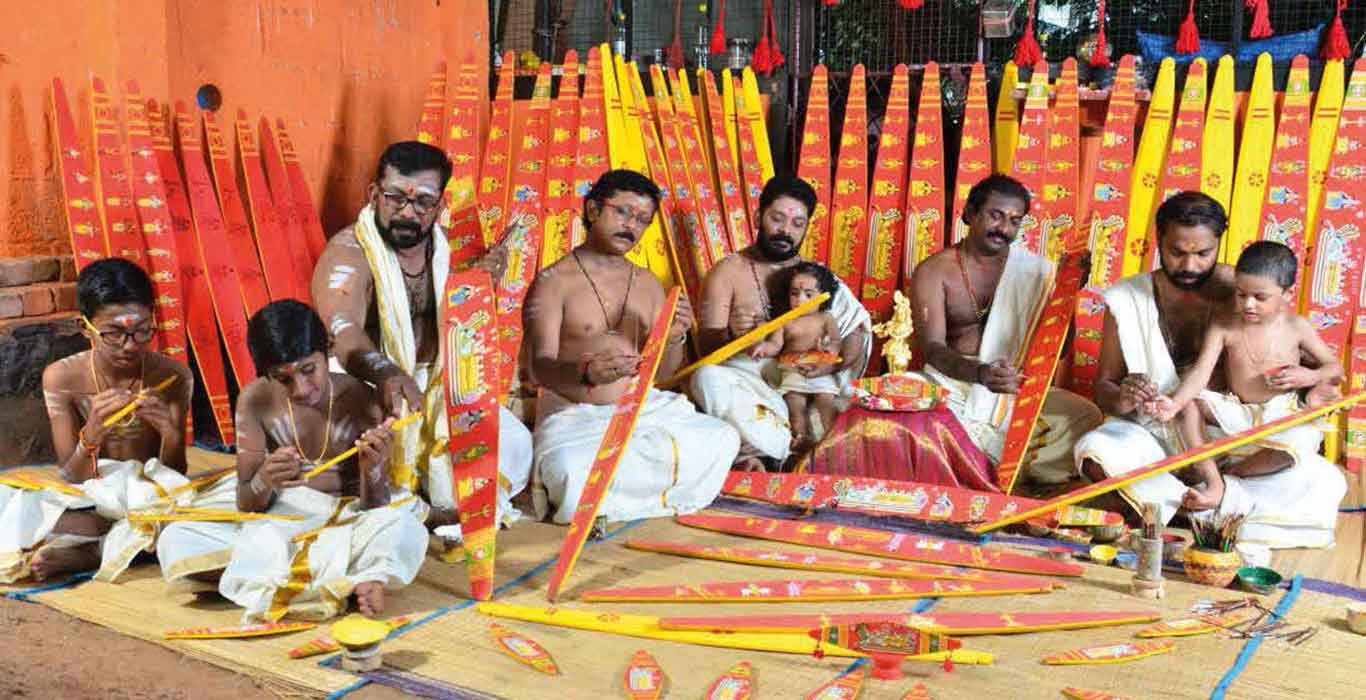The Legends Behind the Bow of prosperity
Text: Anisha Rudrani
Karamana, seven kilometres to the south of Thiruvanthapuram Central, has a distinct landscape. It’s rugged terrains that border the shores of Karamana River is embowered in lush greenery, a feature that makes it sui generis.
Thiruvanathapuram’s own Onavillu (a ceremonial bow-shaped instrument) is made here. The ceremony that has been preserved in its quintessence for generation after generation, the making of Onavillu is Karamana’s unspoken pride. Unsurprising in the modern solitary lifestyle, many citizens of the land are barely aware of this century-old tradition followed in its original form even today, and
about this bow-making family.
Onavillu family, as the family is famously known (and the name is patented so that it’s not taken away from them), takes its origin from one of the five Viswakarma clans, the Mayans. Originally from the neighbouring state of Tamil Nadu, the ancestors of this family came to the
capital city of Kerala to build the Sri Padmanabhaswamy Temple. History has it that Pallivillu, as Onavillu was previously known, was presented by these master craftsmen to Lord Ananthapadmanabhan when the construction of the temple was completed. Since then, the tradition is carried on year after year; generation after generation.
Binkumar, the chief craftsman explains that since ceremonial villus (bows) are presented to the temple during the festival of Onam, it became Onavilllu, suggestive of the time.

Earlier, the making of these bows was seasonal, with the family submitting a pair of six bows to the temple only during the festival times of Onam. But with a semi-commercialization, today the family’s men dedicate their whole time into its making. The evotees can buy the villus and take it home after they are kept in the temple for 3 days during Onam. These ceremonial bows are believed to bring prosperity to home. In a month, 125 bows are made, and this ensures a steady flow of income from the temple to the family.
Preparation of Onavillu
Kadambu and Mahagony trees that are believed to be dearer to Lord Vishnu are therefore used to make the Onavillu. The boat-shaped plank is cut to different sizes, to be submitted to the deities according to their importance. The main deity, Ananthapadmanabhan (Lord Vishnu, second of the Trinity), is crafted on a plank sized 4.5 feet (Ananthasayanam Villu), while NarasimhaMoorthy (Dasavatharam Villu) , Sree Rama (Sree Rama Pattabhishekam Villu)
and Shastha are painted on planks of 4 feet-long, and Sree Krishna (Sree Krishnaleela Villu) and Vinayaka are portrayed in planks sized 3.5 feet. The width of all planks is same at .75 inches.
The preparation of the bows takes 41 days time, and throughout this time the members of the family observe a rigid fast. Originally, ‘Ananthasayanam Villu’, Dasavatharam Villu’, and ‘SreeKrishnaleela Villu’ were consecrated at PadmanabhaSwamy temple. The rest of the bows were introduced in the course of ime, so that all the deities are revered.
History has it that Pallivillu, as Onavillu was previously known, was presented by these master craftsmen to Lord Ananthapadmanabhan when the construction of the temple was completed. Since then, the tradition is carried on year after year; generation aftter generation.
The red tassels (Kunjalam) tied on both sides of the bow are made by convicts in Poojapura Central Jail. This arrangement was introduced by the King at the time, as he was certain that involving the criminals in a ivine matter could change them positively, and would prevent them from committing any crimes thereafter.
Interestingly, people from all religion and castes are involved in the making of Kunjalam. Bin Kumar believes the far-sighted arrangement has a special place in the making of the bows. And the convicts also observe a 21-days’ fast before taking part in the making, so that the holiness of Onavillu remain intact.
At the temple
The ‘villus’ are first offered to the family deity at the Valiya Veedu, now Onavillu family, for three days. They are then taken to Sri Padmanabhaswamy Temple on the Thiruvonam day and are then displayed at the Natakasala before being offered to the deity. Now, the devotees can book the villu via the online platform of the temple, and the same can be taken to their homes after the rituals. The tradition makes the Onavillu family the only family other than the Travancore Royal Family to get directly involved in the temple’s rituals. It is believed Onam is one of the best times to visit the Sri Padmanabhaswamy Temple, since one gets the rate opportunity to see the main deity of Ananthapadmanabhan and other deities adorned with these ceremonial villus.
The preparation of the bows takes 41 days time, and throughout this time the members of the
family observe a rigid fast. Originally, ‘Dasavatharam Villu’, and ‘SreeKrishnaleela Villu’ were
consecrated at PadmanabhaSwamy temple. The rest of the bows were introduced in the course of time, so that all the deities are revered.
The legend
The interesting legend behind the Onavillu goes like this: When Mahabali was vanquished to the nertherlands or ‘pathala’ by Vamana, he wanted to know the real identity of the latter. Vamana then appeared in the form of Lord Vishnu, revealing it was the supreme omni-power himself a heavy-hearted Bin Kumar was
making a visit to the temple when an elderly man robed in veshti (dhoti), stopped him on the way. He asked him why Kumar was looking upset and in reply, the latter expressed his grief of being ‘unrecognized’ since nobody knew about the family who painstakingly make these Onavillus every year. Extending a solution, the old man said, “Don’t worry. Start making chest-sized villus. That will come as a benefit for you and your family.”
Bin Kumar has never seen that man ever again. But ever since the family started making these one-foot villus, which has been selling really well, they believe that old man in Veshti could be none other than Lord Vishnu himself! who had come to bless the King. Extremely elated on seeing the Lord before his eyes, Mahabali pleaded for the permission to visit his land at least once a year and also see Lord during the visit. The Lord granted his wish, but said Mahabali would be able to see him and his avatars only in painted images. Thus the Onavillu was created by Viswakarma.
Extremely elated on seeing the Lord before his eyes, Mahabali pleaded for the permission to visit his land at least once a year and also see Lord during the visit. The Lord granted his wish, but said Mahabali would be able to see him and his avatars only in painted images. Thus the Onavillu was created by Viswakarma.
While all the ceremonials bows are consecrated to the temple, Bin Kumar spills the bean on a 7th type of Onavillu, the smallest of them all, which is sold by the Onavillu famly directly to people with the help of Royal family. Bin Kumar makes these one-foot villus with his brothers’ help. He takes us through an interesting anecdote behind the birth of these tiny bows. Further to a tussle with the temple administration, the family refrained from making the bows during a short while. That Onam, a heavy-hearted Bin Kumar was making a visit to the temple when an elderly man robed in veshti (dhoti), stopped him on the way. He asked him why Kumar was looking upset and in reply, the latter expressed his grief of being ‘unrecognized’ since nobody knew about the family who painstakingly make these Onavillus every year. Extending a solution, the old man said, “Don’t worry. Start making chest-sized villus. That will come as a benefit for you and your family.”
Bin Kumar has never seen that man ever again. But ever since the family started making these one-foot villus, which has been selling really well, they believe that old man in Veshti could be none other than Lord Vishnu himself!




